Management Accounting Report: Strategies for Business Development
VerifiedAdded on 2022/12/19
|15
|4638
|34
Report
AI Summary
This report provides a comprehensive analysis of management accounting, focusing on its vital role in organizational decision-making and sustainable growth. It begins by exploring various management accounting systems such as cost accounting, price optimization, inventory management, and job order costing, emphasizing their importance and applicability. The report then delves into management accounting reporting techniques, including budget reports, performance reports, and cost management reports. The benefits of these systems, such as improved cash flow and better decision-making, are highlighted, along with their correlation to effective reporting. The report further examines the formulation of income statements using marginal and absorption costing methods. The report then discusses the advantages and disadvantages of planning tools, particularly in budgetary control. Finally, it includes a comparative analysis of organizational uses of management accounting techniques to resolve financial issues and achieve organizational success, using Thomas Swan & Company as a case study. The report concludes by emphasizing the importance of management accounting in fostering organizational development and financial stability.
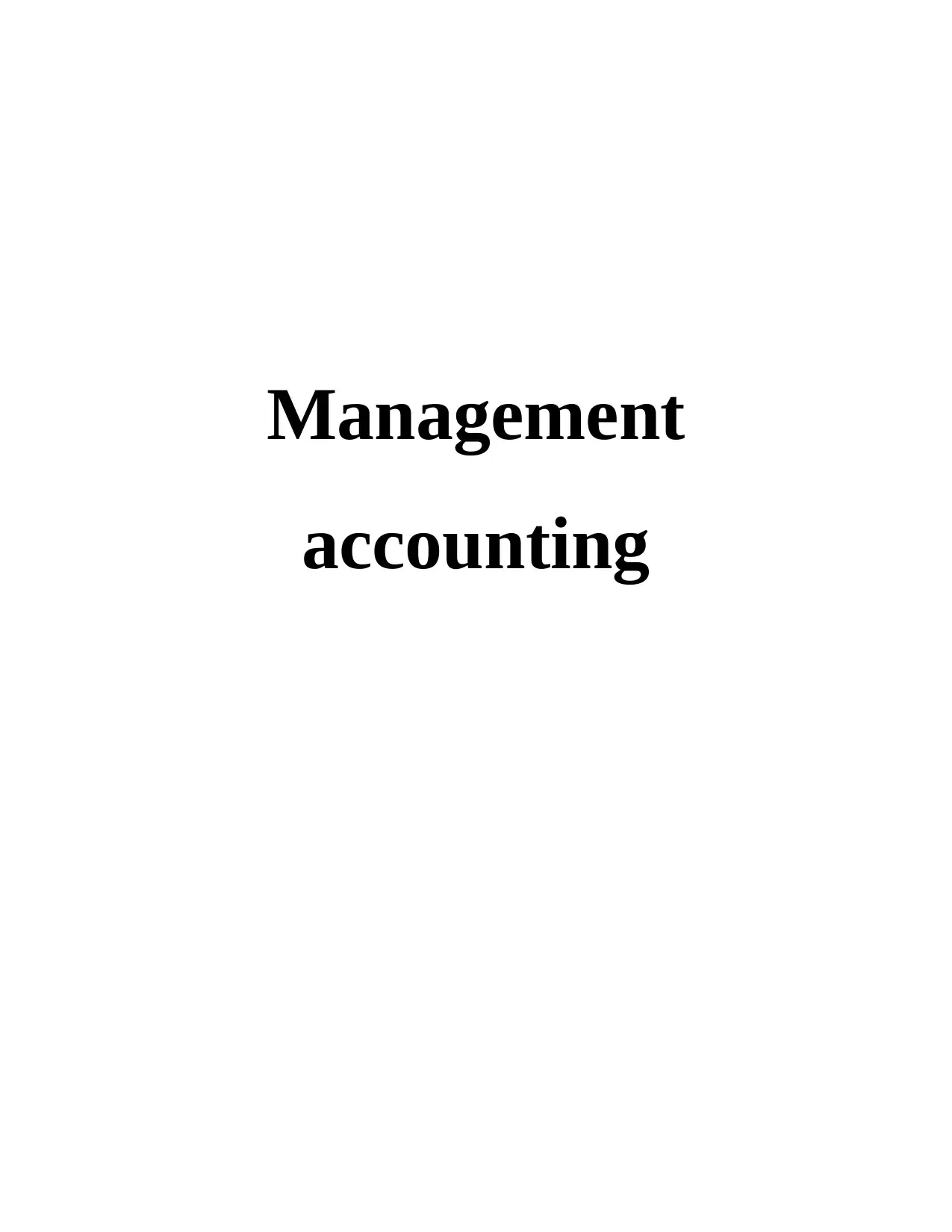
Management
accounting
accounting
Paraphrase This Document
Need a fresh take? Get an instant paraphrase of this document with our AI Paraphraser
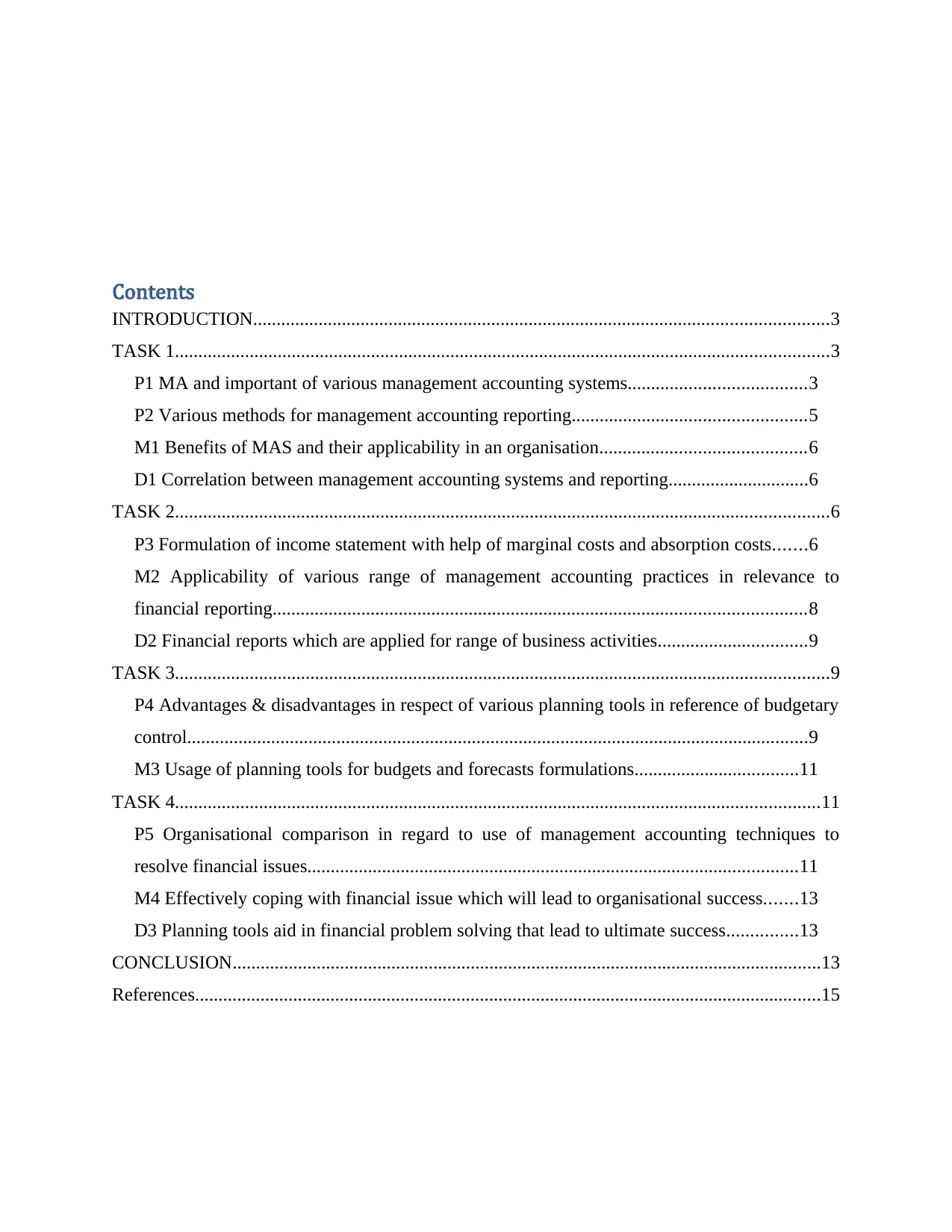
Contents
INTRODUCTION...........................................................................................................................3
TASK 1............................................................................................................................................3
P1 MA and important of various management accounting systems......................................3
P2 Various methods for management accounting reporting..................................................5
M1 Benefits of MAS and their applicability in an organisation............................................6
D1 Correlation between management accounting systems and reporting..............................6
TASK 2............................................................................................................................................6
P3 Formulation of income statement with help of marginal costs and absorption costs.......6
M2 Applicability of various range of management accounting practices in relevance to
financial reporting..................................................................................................................8
D2 Financial reports which are applied for range of business activities................................9
TASK 3............................................................................................................................................9
P4 Advantages & disadvantages in respect of various planning tools in reference of budgetary
control.....................................................................................................................................9
M3 Usage of planning tools for budgets and forecasts formulations...................................11
TASK 4..........................................................................................................................................11
P5 Organisational comparison in regard to use of management accounting techniques to
resolve financial issues.........................................................................................................11
M4 Effectively coping with financial issue which will lead to organisational success.......13
D3 Planning tools aid in financial problem solving that lead to ultimate success...............13
CONCLUSION..............................................................................................................................13
References......................................................................................................................................15
INTRODUCTION...........................................................................................................................3
TASK 1............................................................................................................................................3
P1 MA and important of various management accounting systems......................................3
P2 Various methods for management accounting reporting..................................................5
M1 Benefits of MAS and their applicability in an organisation............................................6
D1 Correlation between management accounting systems and reporting..............................6
TASK 2............................................................................................................................................6
P3 Formulation of income statement with help of marginal costs and absorption costs.......6
M2 Applicability of various range of management accounting practices in relevance to
financial reporting..................................................................................................................8
D2 Financial reports which are applied for range of business activities................................9
TASK 3............................................................................................................................................9
P4 Advantages & disadvantages in respect of various planning tools in reference of budgetary
control.....................................................................................................................................9
M3 Usage of planning tools for budgets and forecasts formulations...................................11
TASK 4..........................................................................................................................................11
P5 Organisational comparison in regard to use of management accounting techniques to
resolve financial issues.........................................................................................................11
M4 Effectively coping with financial issue which will lead to organisational success.......13
D3 Planning tools aid in financial problem solving that lead to ultimate success...............13
CONCLUSION..............................................................................................................................13
References......................................................................................................................................15
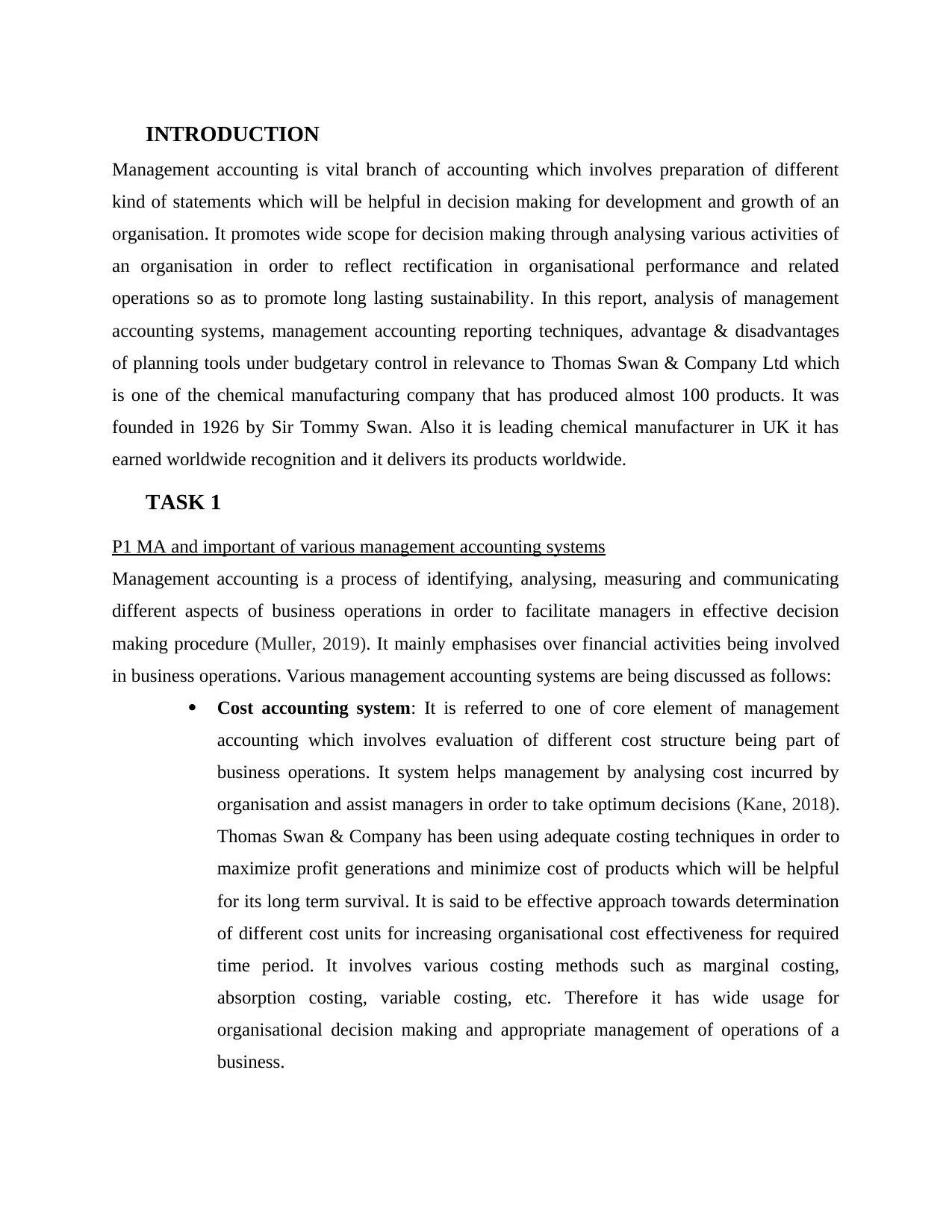
INTRODUCTION
Management accounting is vital branch of accounting which involves preparation of different
kind of statements which will be helpful in decision making for development and growth of an
organisation. It promotes wide scope for decision making through analysing various activities of
an organisation in order to reflect rectification in organisational performance and related
operations so as to promote long lasting sustainability. In this report, analysis of management
accounting systems, management accounting reporting techniques, advantage & disadvantages
of planning tools under budgetary control in relevance to Thomas Swan & Company Ltd which
is one of the chemical manufacturing company that has produced almost 100 products. It was
founded in 1926 by Sir Tommy Swan. Also it is leading chemical manufacturer in UK it has
earned worldwide recognition and it delivers its products worldwide.
TASK 1
P1 MA and important of various management accounting systems
Management accounting is a process of identifying, analysing, measuring and communicating
different aspects of business operations in order to facilitate managers in effective decision
making procedure (Muller, 2019). It mainly emphasises over financial activities being involved
in business operations. Various management accounting systems are being discussed as follows:
Cost accounting system: It is referred to one of core element of management
accounting which involves evaluation of different cost structure being part of
business operations. It system helps management by analysing cost incurred by
organisation and assist managers in order to take optimum decisions (Kane, 2018).
Thomas Swan & Company has been using adequate costing techniques in order to
maximize profit generations and minimize cost of products which will be helpful
for its long term survival. It is said to be effective approach towards determination
of different cost units for increasing organisational cost effectiveness for required
time period. It involves various costing methods such as marginal costing,
absorption costing, variable costing, etc. Therefore it has wide usage for
organisational decision making and appropriate management of operations of a
business.
Management accounting is vital branch of accounting which involves preparation of different
kind of statements which will be helpful in decision making for development and growth of an
organisation. It promotes wide scope for decision making through analysing various activities of
an organisation in order to reflect rectification in organisational performance and related
operations so as to promote long lasting sustainability. In this report, analysis of management
accounting systems, management accounting reporting techniques, advantage & disadvantages
of planning tools under budgetary control in relevance to Thomas Swan & Company Ltd which
is one of the chemical manufacturing company that has produced almost 100 products. It was
founded in 1926 by Sir Tommy Swan. Also it is leading chemical manufacturer in UK it has
earned worldwide recognition and it delivers its products worldwide.
TASK 1
P1 MA and important of various management accounting systems
Management accounting is a process of identifying, analysing, measuring and communicating
different aspects of business operations in order to facilitate managers in effective decision
making procedure (Muller, 2019). It mainly emphasises over financial activities being involved
in business operations. Various management accounting systems are being discussed as follows:
Cost accounting system: It is referred to one of core element of management
accounting which involves evaluation of different cost structure being part of
business operations. It system helps management by analysing cost incurred by
organisation and assist managers in order to take optimum decisions (Kane, 2018).
Thomas Swan & Company has been using adequate costing techniques in order to
maximize profit generations and minimize cost of products which will be helpful
for its long term survival. It is said to be effective approach towards determination
of different cost units for increasing organisational cost effectiveness for required
time period. It involves various costing methods such as marginal costing,
absorption costing, variable costing, etc. Therefore it has wide usage for
organisational decision making and appropriate management of operations of a
business.
⊘ This is a preview!⊘
Do you want full access?
Subscribe today to unlock all pages.

Trusted by 1+ million students worldwide
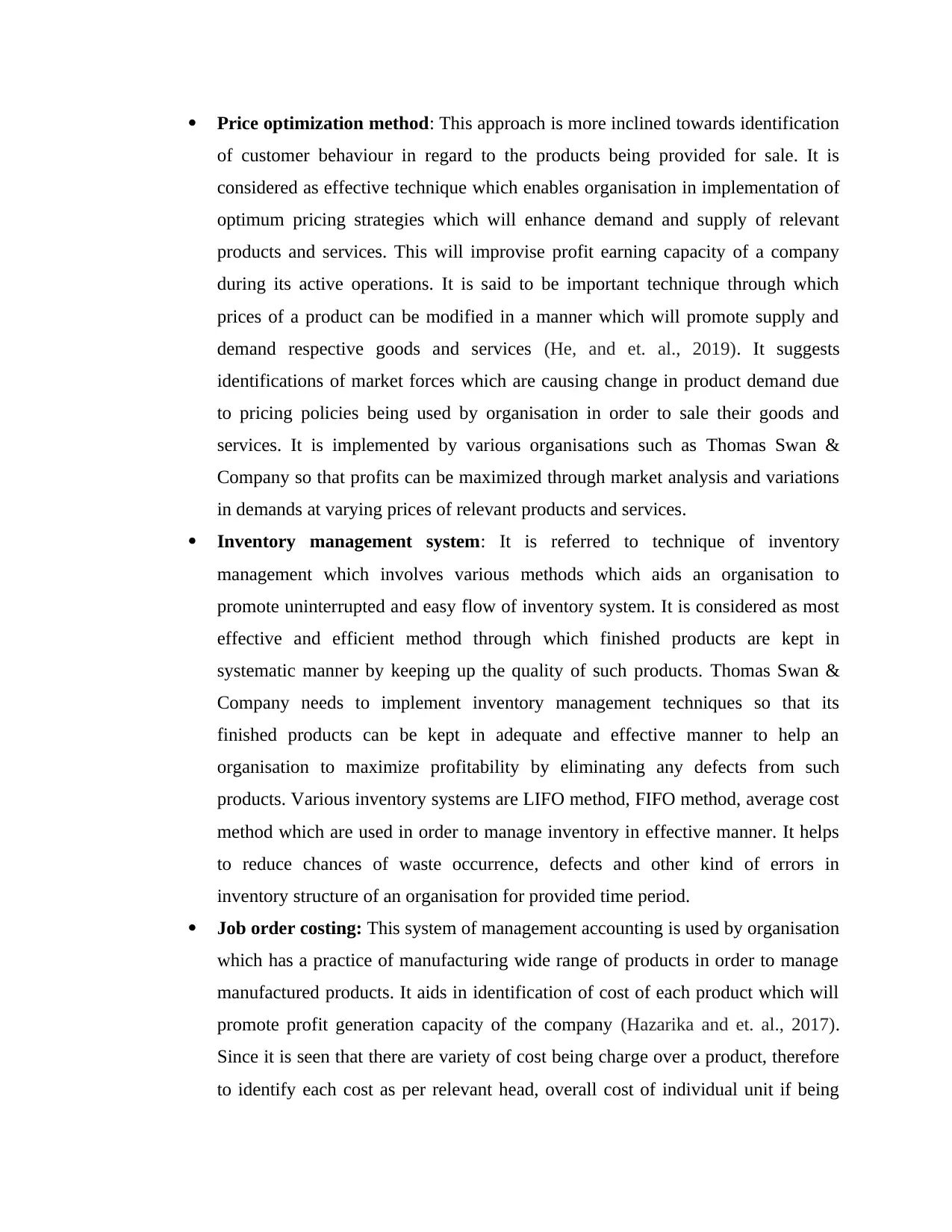
Price optimization method: This approach is more inclined towards identification
of customer behaviour in regard to the products being provided for sale. It is
considered as effective technique which enables organisation in implementation of
optimum pricing strategies which will enhance demand and supply of relevant
products and services. This will improvise profit earning capacity of a company
during its active operations. It is said to be important technique through which
prices of a product can be modified in a manner which will promote supply and
demand respective goods and services (He, and et. al., 2019). It suggests
identifications of market forces which are causing change in product demand due
to pricing policies being used by organisation in order to sale their goods and
services. It is implemented by various organisations such as Thomas Swan &
Company so that profits can be maximized through market analysis and variations
in demands at varying prices of relevant products and services.
Inventory management system: It is referred to technique of inventory
management which involves various methods which aids an organisation to
promote uninterrupted and easy flow of inventory system. It is considered as most
effective and efficient method through which finished products are kept in
systematic manner by keeping up the quality of such products. Thomas Swan &
Company needs to implement inventory management techniques so that its
finished products can be kept in adequate and effective manner to help an
organisation to maximize profitability by eliminating any defects from such
products. Various inventory systems are LIFO method, FIFO method, average cost
method which are used in order to manage inventory in effective manner. It helps
to reduce chances of waste occurrence, defects and other kind of errors in
inventory structure of an organisation for provided time period.
Job order costing: This system of management accounting is used by organisation
which has a practice of manufacturing wide range of products in order to manage
manufactured products. It aids in identification of cost of each product which will
promote profit generation capacity of the company (Hazarika and et. al., 2017).
Since it is seen that there are variety of cost being charge over a product, therefore
to identify each cost as per relevant head, overall cost of individual unit if being
of customer behaviour in regard to the products being provided for sale. It is
considered as effective technique which enables organisation in implementation of
optimum pricing strategies which will enhance demand and supply of relevant
products and services. This will improvise profit earning capacity of a company
during its active operations. It is said to be important technique through which
prices of a product can be modified in a manner which will promote supply and
demand respective goods and services (He, and et. al., 2019). It suggests
identifications of market forces which are causing change in product demand due
to pricing policies being used by organisation in order to sale their goods and
services. It is implemented by various organisations such as Thomas Swan &
Company so that profits can be maximized through market analysis and variations
in demands at varying prices of relevant products and services.
Inventory management system: It is referred to technique of inventory
management which involves various methods which aids an organisation to
promote uninterrupted and easy flow of inventory system. It is considered as most
effective and efficient method through which finished products are kept in
systematic manner by keeping up the quality of such products. Thomas Swan &
Company needs to implement inventory management techniques so that its
finished products can be kept in adequate and effective manner to help an
organisation to maximize profitability by eliminating any defects from such
products. Various inventory systems are LIFO method, FIFO method, average cost
method which are used in order to manage inventory in effective manner. It helps
to reduce chances of waste occurrence, defects and other kind of errors in
inventory structure of an organisation for provided time period.
Job order costing: This system of management accounting is used by organisation
which has a practice of manufacturing wide range of products in order to manage
manufactured products. It aids in identification of cost of each product which will
promote profit generation capacity of the company (Hazarika and et. al., 2017).
Since it is seen that there are variety of cost being charge over a product, therefore
to identify each cost as per relevant head, overall cost of individual unit if being
Paraphrase This Document
Need a fresh take? Get an instant paraphrase of this document with our AI Paraphraser
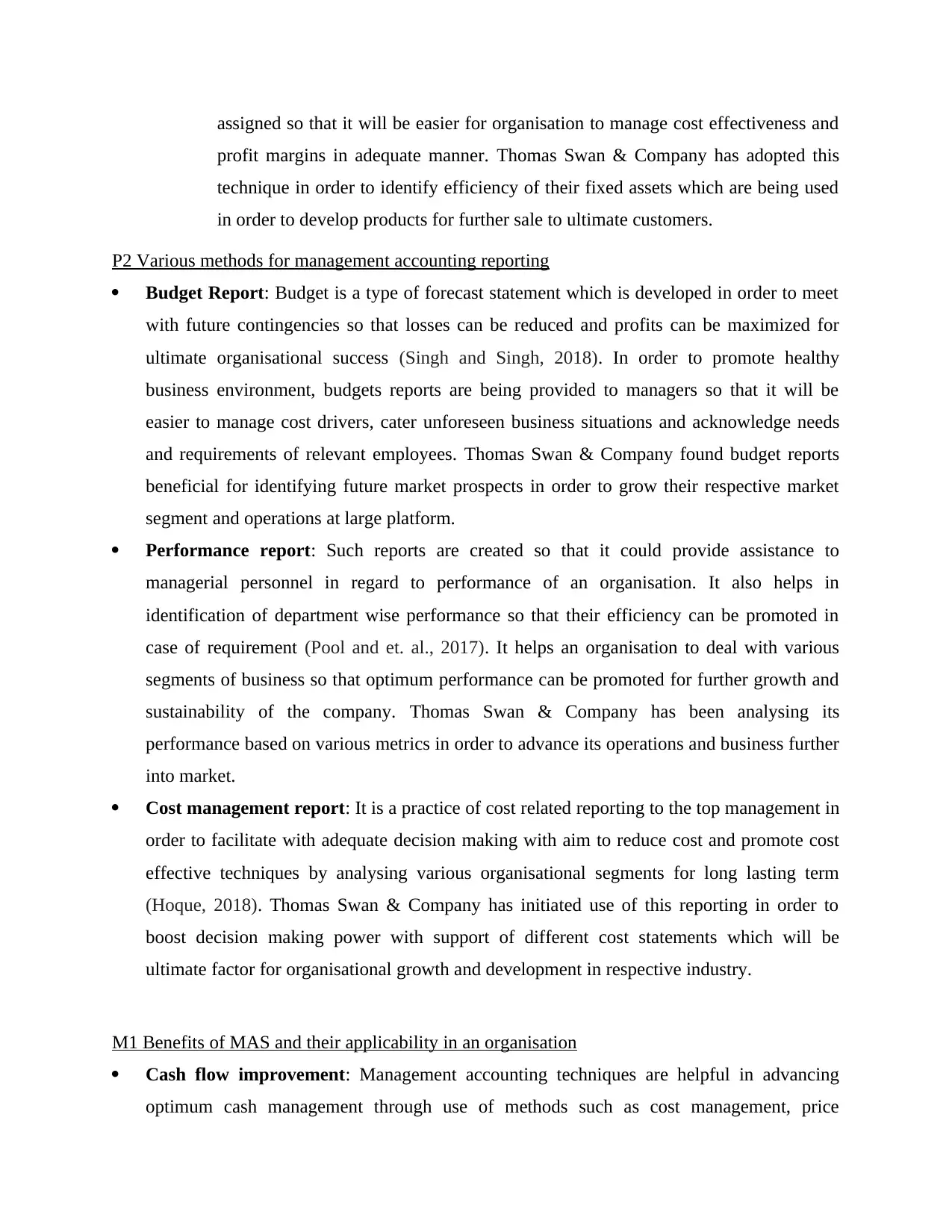
assigned so that it will be easier for organisation to manage cost effectiveness and
profit margins in adequate manner. Thomas Swan & Company has adopted this
technique in order to identify efficiency of their fixed assets which are being used
in order to develop products for further sale to ultimate customers.
P2 Various methods for management accounting reporting
Budget Report: Budget is a type of forecast statement which is developed in order to meet
with future contingencies so that losses can be reduced and profits can be maximized for
ultimate organisational success (Singh and Singh, 2018). In order to promote healthy
business environment, budgets reports are being provided to managers so that it will be
easier to manage cost drivers, cater unforeseen business situations and acknowledge needs
and requirements of relevant employees. Thomas Swan & Company found budget reports
beneficial for identifying future market prospects in order to grow their respective market
segment and operations at large platform.
Performance report: Such reports are created so that it could provide assistance to
managerial personnel in regard to performance of an organisation. It also helps in
identification of department wise performance so that their efficiency can be promoted in
case of requirement (Pool and et. al., 2017). It helps an organisation to deal with various
segments of business so that optimum performance can be promoted for further growth and
sustainability of the company. Thomas Swan & Company has been analysing its
performance based on various metrics in order to advance its operations and business further
into market.
Cost management report: It is a practice of cost related reporting to the top management in
order to facilitate with adequate decision making with aim to reduce cost and promote cost
effective techniques by analysing various organisational segments for long lasting term
(Hoque, 2018). Thomas Swan & Company has initiated use of this reporting in order to
boost decision making power with support of different cost statements which will be
ultimate factor for organisational growth and development in respective industry.
M1 Benefits of MAS and their applicability in an organisation
Cash flow improvement: Management accounting techniques are helpful in advancing
optimum cash management through use of methods such as cost management, price
profit margins in adequate manner. Thomas Swan & Company has adopted this
technique in order to identify efficiency of their fixed assets which are being used
in order to develop products for further sale to ultimate customers.
P2 Various methods for management accounting reporting
Budget Report: Budget is a type of forecast statement which is developed in order to meet
with future contingencies so that losses can be reduced and profits can be maximized for
ultimate organisational success (Singh and Singh, 2018). In order to promote healthy
business environment, budgets reports are being provided to managers so that it will be
easier to manage cost drivers, cater unforeseen business situations and acknowledge needs
and requirements of relevant employees. Thomas Swan & Company found budget reports
beneficial for identifying future market prospects in order to grow their respective market
segment and operations at large platform.
Performance report: Such reports are created so that it could provide assistance to
managerial personnel in regard to performance of an organisation. It also helps in
identification of department wise performance so that their efficiency can be promoted in
case of requirement (Pool and et. al., 2017). It helps an organisation to deal with various
segments of business so that optimum performance can be promoted for further growth and
sustainability of the company. Thomas Swan & Company has been analysing its
performance based on various metrics in order to advance its operations and business further
into market.
Cost management report: It is a practice of cost related reporting to the top management in
order to facilitate with adequate decision making with aim to reduce cost and promote cost
effective techniques by analysing various organisational segments for long lasting term
(Hoque, 2018). Thomas Swan & Company has initiated use of this reporting in order to
boost decision making power with support of different cost statements which will be
ultimate factor for organisational growth and development in respective industry.
M1 Benefits of MAS and their applicability in an organisation
Cash flow improvement: Management accounting techniques are helpful in advancing
optimum cash management through use of methods such as cost management, price
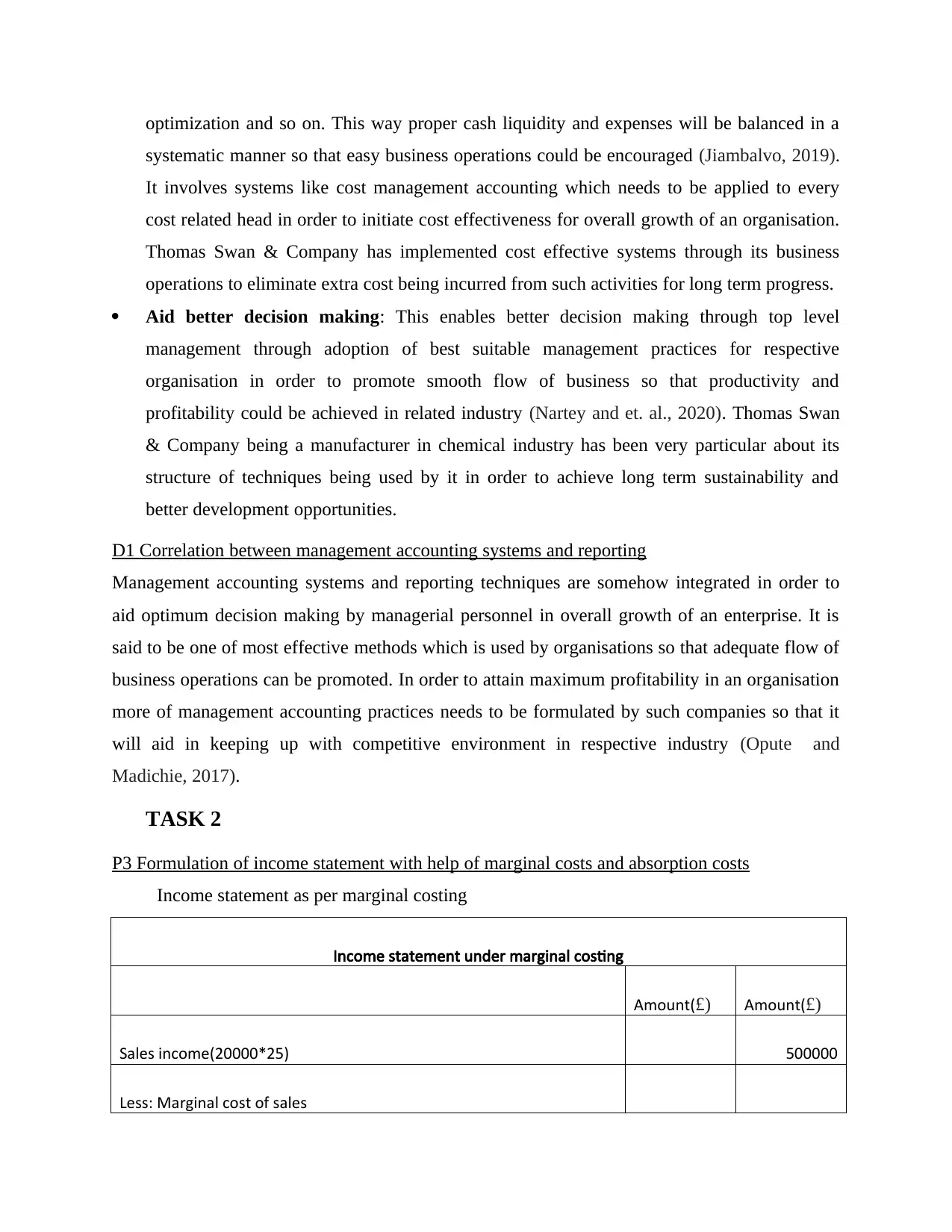
optimization and so on. This way proper cash liquidity and expenses will be balanced in a
systematic manner so that easy business operations could be encouraged (Jiambalvo, 2019).
It involves systems like cost management accounting which needs to be applied to every
cost related head in order to initiate cost effectiveness for overall growth of an organisation.
Thomas Swan & Company has implemented cost effective systems through its business
operations to eliminate extra cost being incurred from such activities for long term progress.
Aid better decision making: This enables better decision making through top level
management through adoption of best suitable management practices for respective
organisation in order to promote smooth flow of business so that productivity and
profitability could be achieved in related industry (Nartey and et. al., 2020). Thomas Swan
& Company being a manufacturer in chemical industry has been very particular about its
structure of techniques being used by it in order to achieve long term sustainability and
better development opportunities.
D1 Correlation between management accounting systems and reporting
Management accounting systems and reporting techniques are somehow integrated in order to
aid optimum decision making by managerial personnel in overall growth of an enterprise. It is
said to be one of most effective methods which is used by organisations so that adequate flow of
business operations can be promoted. In order to attain maximum profitability in an organisation
more of management accounting practices needs to be formulated by such companies so that it
will aid in keeping up with competitive environment in respective industry (Opute and
Madichie, 2017).
TASK 2
P3 Formulation of income statement with help of marginal costs and absorption costs
Income statement as per marginal costing
Income statement under marginal costing
Amount(£) Amount(£)
Sales income(20000*25) 500000
Less: Marginal cost of sales
systematic manner so that easy business operations could be encouraged (Jiambalvo, 2019).
It involves systems like cost management accounting which needs to be applied to every
cost related head in order to initiate cost effectiveness for overall growth of an organisation.
Thomas Swan & Company has implemented cost effective systems through its business
operations to eliminate extra cost being incurred from such activities for long term progress.
Aid better decision making: This enables better decision making through top level
management through adoption of best suitable management practices for respective
organisation in order to promote smooth flow of business so that productivity and
profitability could be achieved in related industry (Nartey and et. al., 2020). Thomas Swan
& Company being a manufacturer in chemical industry has been very particular about its
structure of techniques being used by it in order to achieve long term sustainability and
better development opportunities.
D1 Correlation between management accounting systems and reporting
Management accounting systems and reporting techniques are somehow integrated in order to
aid optimum decision making by managerial personnel in overall growth of an enterprise. It is
said to be one of most effective methods which is used by organisations so that adequate flow of
business operations can be promoted. In order to attain maximum profitability in an organisation
more of management accounting practices needs to be formulated by such companies so that it
will aid in keeping up with competitive environment in respective industry (Opute and
Madichie, 2017).
TASK 2
P3 Formulation of income statement with help of marginal costs and absorption costs
Income statement as per marginal costing
Income statement under marginal costing
Amount(£) Amount(£)
Sales income(20000*25) 500000
Less: Marginal cost of sales
⊘ This is a preview!⊘
Do you want full access?
Subscribe today to unlock all pages.

Trusted by 1+ million students worldwide
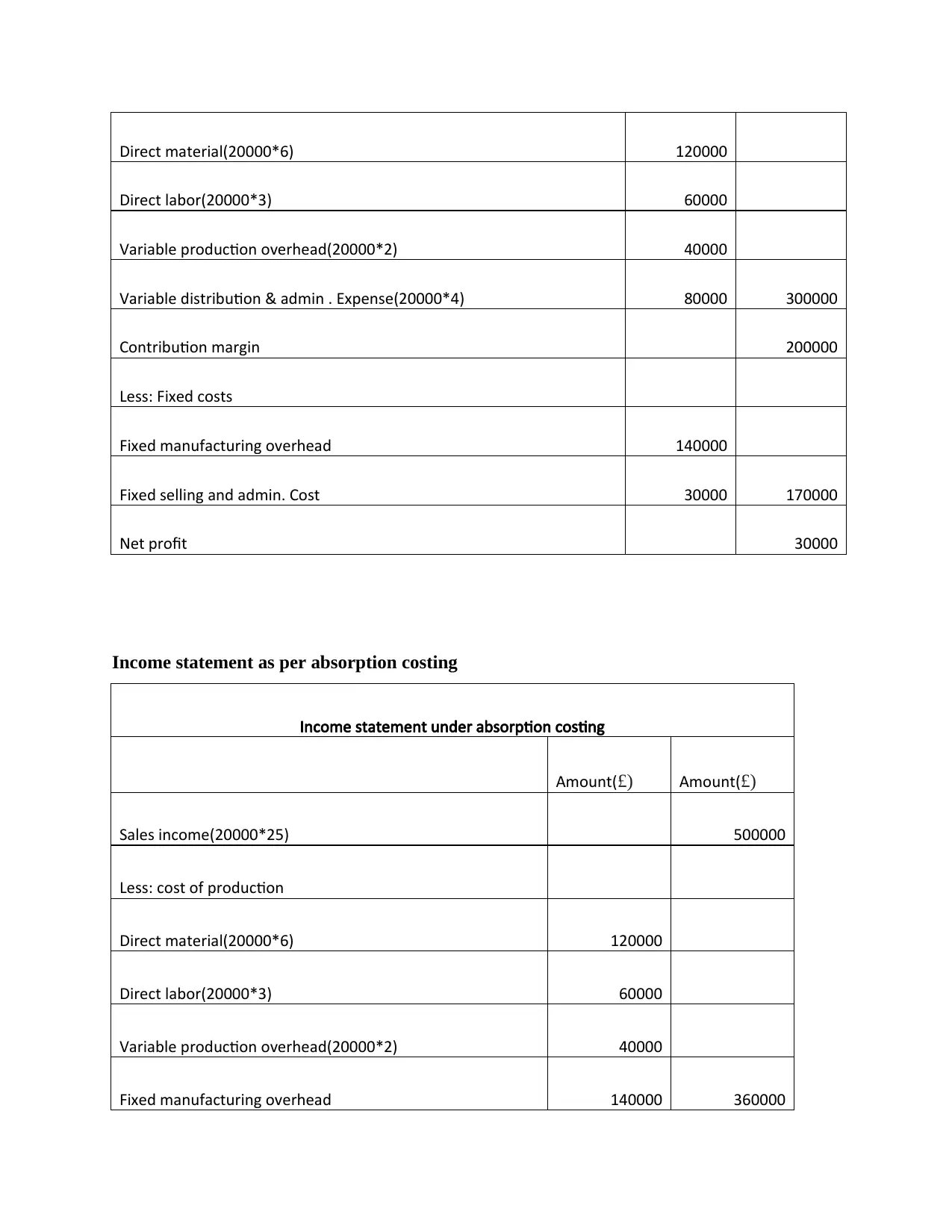
Direct material(20000*6) 120000
Direct labor(20000*3) 60000
Variable production overhead(20000*2) 40000
Variable distribution & admin . Expense(20000*4) 80000 300000
Contribution margin 200000
Less: Fixed costs
Fixed manufacturing overhead 140000
Fixed selling and admin. Cost 30000 170000
Net profit 30000
Income statement as per absorption costing
Income statement under absorption costing
Amount(£) Amount(£)
Sales income(20000*25) 500000
Less: cost of production
Direct material(20000*6) 120000
Direct labor(20000*3) 60000
Variable production overhead(20000*2) 40000
Fixed manufacturing overhead 140000 360000
Direct labor(20000*3) 60000
Variable production overhead(20000*2) 40000
Variable distribution & admin . Expense(20000*4) 80000 300000
Contribution margin 200000
Less: Fixed costs
Fixed manufacturing overhead 140000
Fixed selling and admin. Cost 30000 170000
Net profit 30000
Income statement as per absorption costing
Income statement under absorption costing
Amount(£) Amount(£)
Sales income(20000*25) 500000
Less: cost of production
Direct material(20000*6) 120000
Direct labor(20000*3) 60000
Variable production overhead(20000*2) 40000
Fixed manufacturing overhead 140000 360000
Paraphrase This Document
Need a fresh take? Get an instant paraphrase of this document with our AI Paraphraser
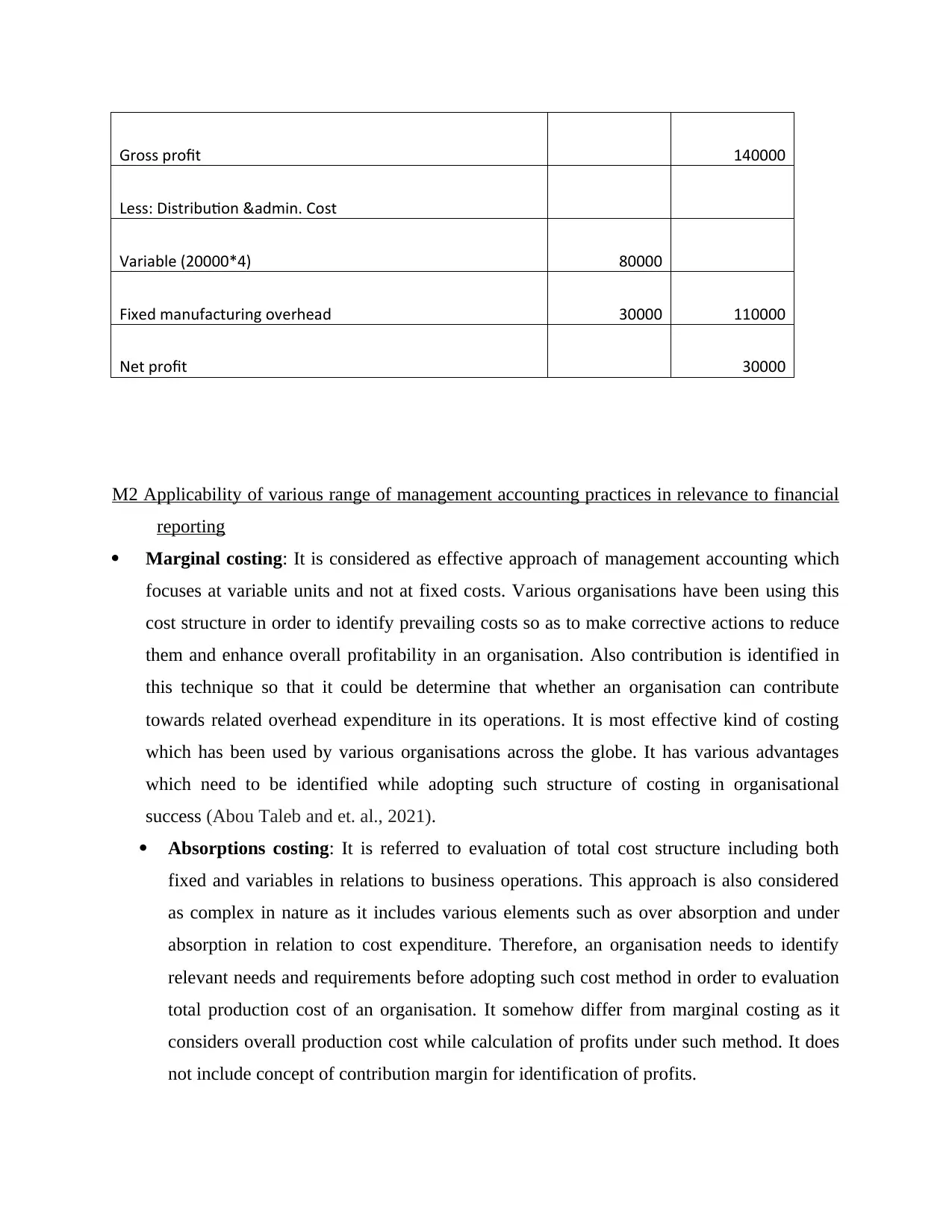
Gross profit 140000
Less: Distribution &admin. Cost
Variable (20000*4) 80000
Fixed manufacturing overhead 30000 110000
Net profit 30000
M2 Applicability of various range of management accounting practices in relevance to financial
reporting
Marginal costing: It is considered as effective approach of management accounting which
focuses at variable units and not at fixed costs. Various organisations have been using this
cost structure in order to identify prevailing costs so as to make corrective actions to reduce
them and enhance overall profitability in an organisation. Also contribution is identified in
this technique so that it could be determine that whether an organisation can contribute
towards related overhead expenditure in its operations. It is most effective kind of costing
which has been used by various organisations across the globe. It has various advantages
which need to be identified while adopting such structure of costing in organisational
success (Abou Taleb and et. al., 2021).
Absorptions costing: It is referred to evaluation of total cost structure including both
fixed and variables in relations to business operations. This approach is also considered
as complex in nature as it includes various elements such as over absorption and under
absorption in relation to cost expenditure. Therefore, an organisation needs to identify
relevant needs and requirements before adopting such cost method in order to evaluation
total production cost of an organisation. It somehow differ from marginal costing as it
considers overall production cost while calculation of profits under such method. It does
not include concept of contribution margin for identification of profits.
Less: Distribution &admin. Cost
Variable (20000*4) 80000
Fixed manufacturing overhead 30000 110000
Net profit 30000
M2 Applicability of various range of management accounting practices in relevance to financial
reporting
Marginal costing: It is considered as effective approach of management accounting which
focuses at variable units and not at fixed costs. Various organisations have been using this
cost structure in order to identify prevailing costs so as to make corrective actions to reduce
them and enhance overall profitability in an organisation. Also contribution is identified in
this technique so that it could be determine that whether an organisation can contribute
towards related overhead expenditure in its operations. It is most effective kind of costing
which has been used by various organisations across the globe. It has various advantages
which need to be identified while adopting such structure of costing in organisational
success (Abou Taleb and et. al., 2021).
Absorptions costing: It is referred to evaluation of total cost structure including both
fixed and variables in relations to business operations. This approach is also considered
as complex in nature as it includes various elements such as over absorption and under
absorption in relation to cost expenditure. Therefore, an organisation needs to identify
relevant needs and requirements before adopting such cost method in order to evaluation
total production cost of an organisation. It somehow differ from marginal costing as it
considers overall production cost while calculation of profits under such method. It does
not include concept of contribution margin for identification of profits.
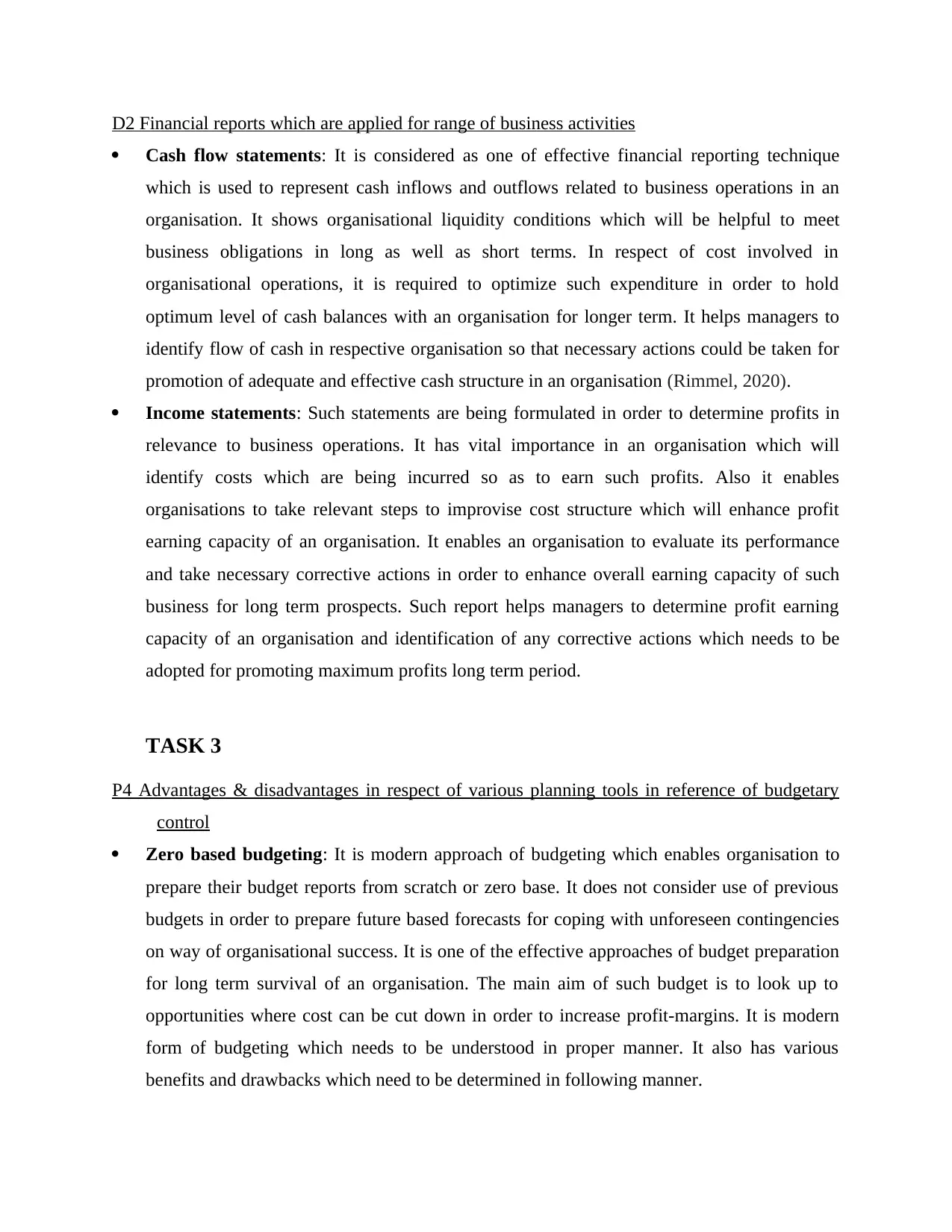
D2 Financial reports which are applied for range of business activities
Cash flow statements: It is considered as one of effective financial reporting technique
which is used to represent cash inflows and outflows related to business operations in an
organisation. It shows organisational liquidity conditions which will be helpful to meet
business obligations in long as well as short terms. In respect of cost involved in
organisational operations, it is required to optimize such expenditure in order to hold
optimum level of cash balances with an organisation for longer term. It helps managers to
identify flow of cash in respective organisation so that necessary actions could be taken for
promotion of adequate and effective cash structure in an organisation (Rimmel, 2020).
Income statements: Such statements are being formulated in order to determine profits in
relevance to business operations. It has vital importance in an organisation which will
identify costs which are being incurred so as to earn such profits. Also it enables
organisations to take relevant steps to improvise cost structure which will enhance profit
earning capacity of an organisation. It enables an organisation to evaluate its performance
and take necessary corrective actions in order to enhance overall earning capacity of such
business for long term prospects. Such report helps managers to determine profit earning
capacity of an organisation and identification of any corrective actions which needs to be
adopted for promoting maximum profits long term period.
TASK 3
P4 Advantages & disadvantages in respect of various planning tools in reference of budgetary
control
Zero based budgeting: It is modern approach of budgeting which enables organisation to
prepare their budget reports from scratch or zero base. It does not consider use of previous
budgets in order to prepare future based forecasts for coping with unforeseen contingencies
on way of organisational success. It is one of the effective approaches of budget preparation
for long term survival of an organisation. The main aim of such budget is to look up to
opportunities where cost can be cut down in order to increase profit-margins. It is modern
form of budgeting which needs to be understood in proper manner. It also has various
benefits and drawbacks which need to be determined in following manner.
Cash flow statements: It is considered as one of effective financial reporting technique
which is used to represent cash inflows and outflows related to business operations in an
organisation. It shows organisational liquidity conditions which will be helpful to meet
business obligations in long as well as short terms. In respect of cost involved in
organisational operations, it is required to optimize such expenditure in order to hold
optimum level of cash balances with an organisation for longer term. It helps managers to
identify flow of cash in respective organisation so that necessary actions could be taken for
promotion of adequate and effective cash structure in an organisation (Rimmel, 2020).
Income statements: Such statements are being formulated in order to determine profits in
relevance to business operations. It has vital importance in an organisation which will
identify costs which are being incurred so as to earn such profits. Also it enables
organisations to take relevant steps to improvise cost structure which will enhance profit
earning capacity of an organisation. It enables an organisation to evaluate its performance
and take necessary corrective actions in order to enhance overall earning capacity of such
business for long term prospects. Such report helps managers to determine profit earning
capacity of an organisation and identification of any corrective actions which needs to be
adopted for promoting maximum profits long term period.
TASK 3
P4 Advantages & disadvantages in respect of various planning tools in reference of budgetary
control
Zero based budgeting: It is modern approach of budgeting which enables organisation to
prepare their budget reports from scratch or zero base. It does not consider use of previous
budgets in order to prepare future based forecasts for coping with unforeseen contingencies
on way of organisational success. It is one of the effective approaches of budget preparation
for long term survival of an organisation. The main aim of such budget is to look up to
opportunities where cost can be cut down in order to increase profit-margins. It is modern
form of budgeting which needs to be understood in proper manner. It also has various
benefits and drawbacks which need to be determined in following manner.
⊘ This is a preview!⊘
Do you want full access?
Subscribe today to unlock all pages.

Trusted by 1+ million students worldwide
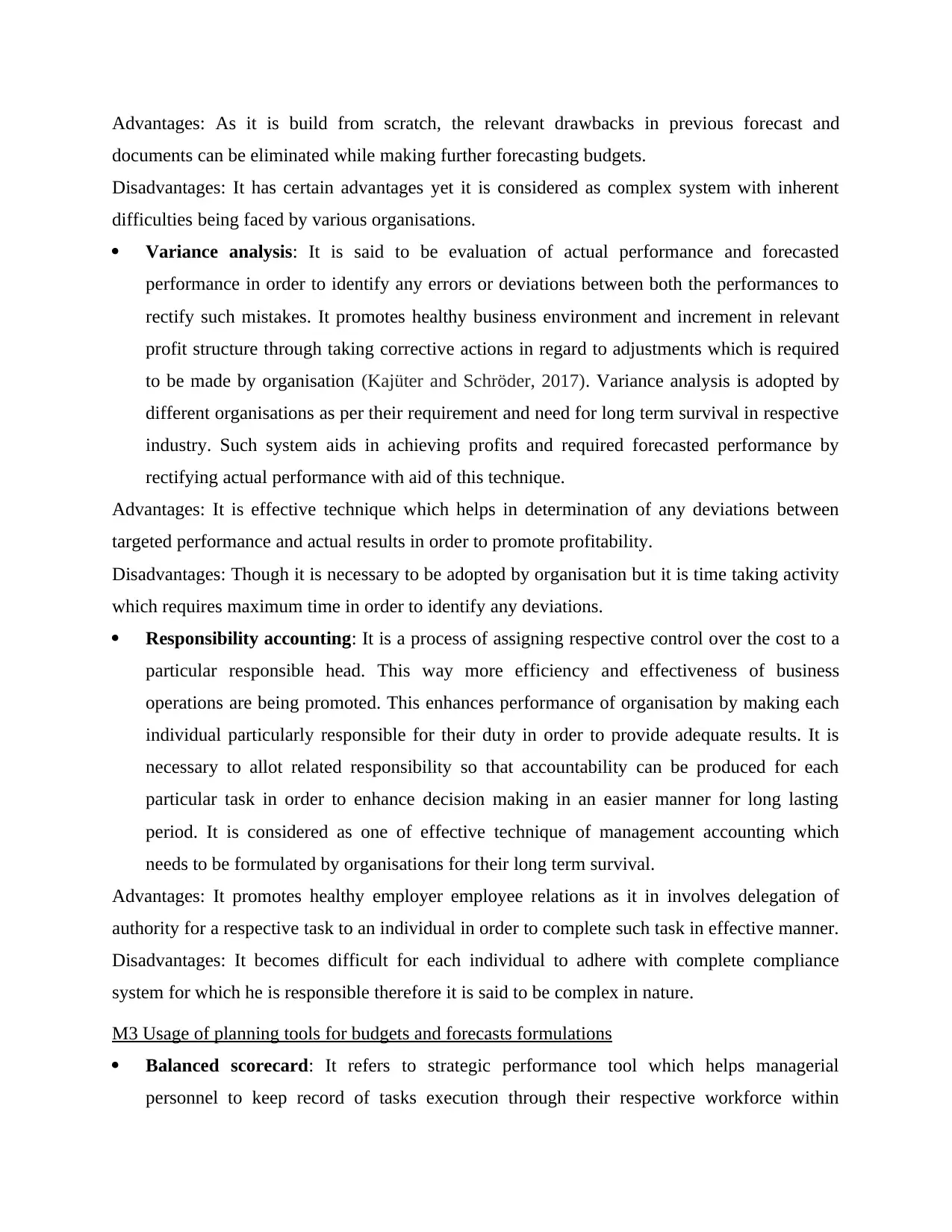
Advantages: As it is build from scratch, the relevant drawbacks in previous forecast and
documents can be eliminated while making further forecasting budgets.
Disadvantages: It has certain advantages yet it is considered as complex system with inherent
difficulties being faced by various organisations.
Variance analysis: It is said to be evaluation of actual performance and forecasted
performance in order to identify any errors or deviations between both the performances to
rectify such mistakes. It promotes healthy business environment and increment in relevant
profit structure through taking corrective actions in regard to adjustments which is required
to be made by organisation (Kajüter and Schröder, 2017). Variance analysis is adopted by
different organisations as per their requirement and need for long term survival in respective
industry. Such system aids in achieving profits and required forecasted performance by
rectifying actual performance with aid of this technique.
Advantages: It is effective technique which helps in determination of any deviations between
targeted performance and actual results in order to promote profitability.
Disadvantages: Though it is necessary to be adopted by organisation but it is time taking activity
which requires maximum time in order to identify any deviations.
Responsibility accounting: It is a process of assigning respective control over the cost to a
particular responsible head. This way more efficiency and effectiveness of business
operations are being promoted. This enhances performance of organisation by making each
individual particularly responsible for their duty in order to provide adequate results. It is
necessary to allot related responsibility so that accountability can be produced for each
particular task in order to enhance decision making in an easier manner for long lasting
period. It is considered as one of effective technique of management accounting which
needs to be formulated by organisations for their long term survival.
Advantages: It promotes healthy employer employee relations as it in involves delegation of
authority for a respective task to an individual in order to complete such task in effective manner.
Disadvantages: It becomes difficult for each individual to adhere with complete compliance
system for which he is responsible therefore it is said to be complex in nature.
M3 Usage of planning tools for budgets and forecasts formulations
Balanced scorecard: It refers to strategic performance tool which helps managerial
personnel to keep record of tasks execution through their respective workforce within
documents can be eliminated while making further forecasting budgets.
Disadvantages: It has certain advantages yet it is considered as complex system with inherent
difficulties being faced by various organisations.
Variance analysis: It is said to be evaluation of actual performance and forecasted
performance in order to identify any errors or deviations between both the performances to
rectify such mistakes. It promotes healthy business environment and increment in relevant
profit structure through taking corrective actions in regard to adjustments which is required
to be made by organisation (Kajüter and Schröder, 2017). Variance analysis is adopted by
different organisations as per their requirement and need for long term survival in respective
industry. Such system aids in achieving profits and required forecasted performance by
rectifying actual performance with aid of this technique.
Advantages: It is effective technique which helps in determination of any deviations between
targeted performance and actual results in order to promote profitability.
Disadvantages: Though it is necessary to be adopted by organisation but it is time taking activity
which requires maximum time in order to identify any deviations.
Responsibility accounting: It is a process of assigning respective control over the cost to a
particular responsible head. This way more efficiency and effectiveness of business
operations are being promoted. This enhances performance of organisation by making each
individual particularly responsible for their duty in order to provide adequate results. It is
necessary to allot related responsibility so that accountability can be produced for each
particular task in order to enhance decision making in an easier manner for long lasting
period. It is considered as one of effective technique of management accounting which
needs to be formulated by organisations for their long term survival.
Advantages: It promotes healthy employer employee relations as it in involves delegation of
authority for a respective task to an individual in order to complete such task in effective manner.
Disadvantages: It becomes difficult for each individual to adhere with complete compliance
system for which he is responsible therefore it is said to be complex in nature.
M3 Usage of planning tools for budgets and forecasts formulations
Balanced scorecard: It refers to strategic performance tool which helps managerial
personnel to keep record of tasks execution through their respective workforce within
Paraphrase This Document
Need a fresh take? Get an instant paraphrase of this document with our AI Paraphraser
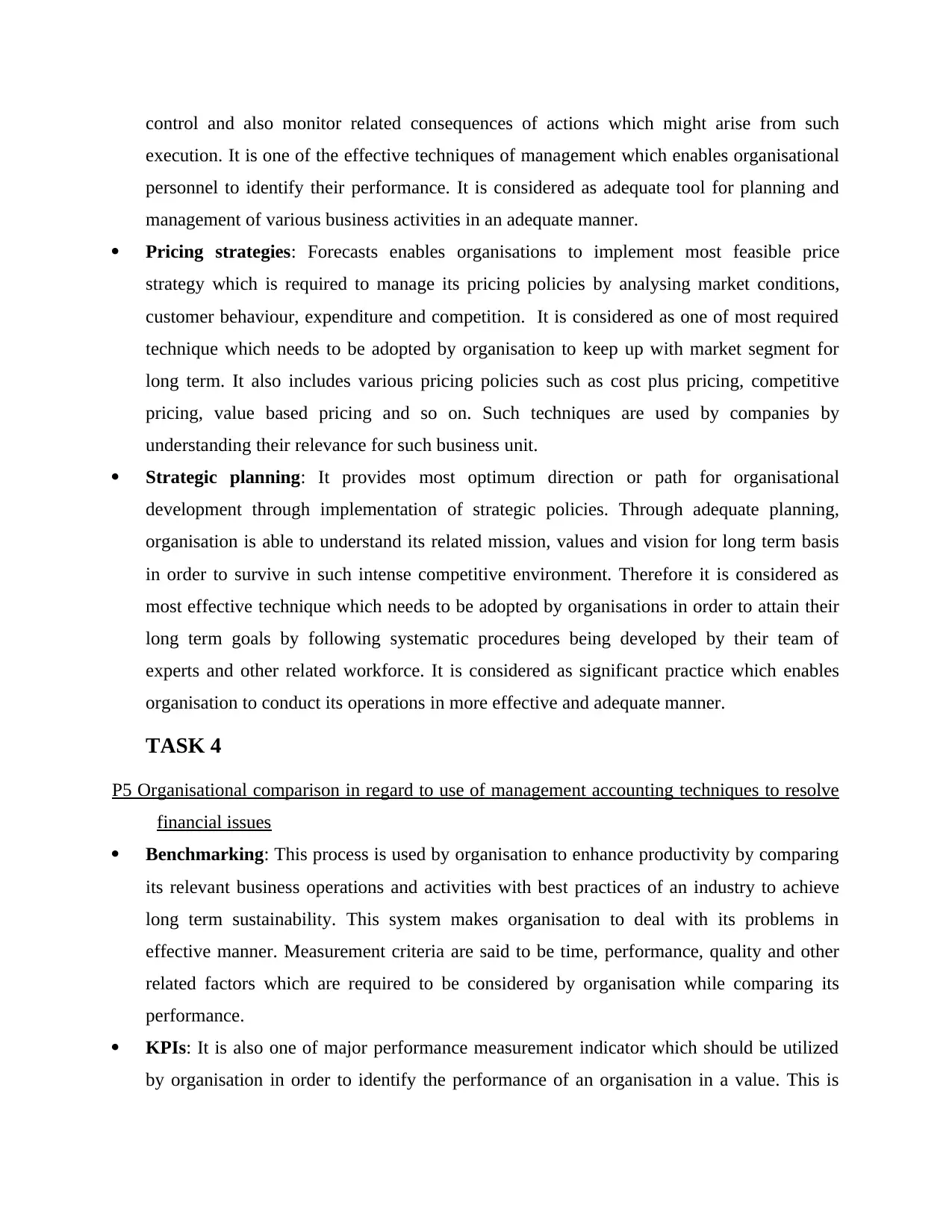
control and also monitor related consequences of actions which might arise from such
execution. It is one of the effective techniques of management which enables organisational
personnel to identify their performance. It is considered as adequate tool for planning and
management of various business activities in an adequate manner.
Pricing strategies: Forecasts enables organisations to implement most feasible price
strategy which is required to manage its pricing policies by analysing market conditions,
customer behaviour, expenditure and competition. It is considered as one of most required
technique which needs to be adopted by organisation to keep up with market segment for
long term. It also includes various pricing policies such as cost plus pricing, competitive
pricing, value based pricing and so on. Such techniques are used by companies by
understanding their relevance for such business unit.
Strategic planning: It provides most optimum direction or path for organisational
development through implementation of strategic policies. Through adequate planning,
organisation is able to understand its related mission, values and vision for long term basis
in order to survive in such intense competitive environment. Therefore it is considered as
most effective technique which needs to be adopted by organisations in order to attain their
long term goals by following systematic procedures being developed by their team of
experts and other related workforce. It is considered as significant practice which enables
organisation to conduct its operations in more effective and adequate manner.
TASK 4
P5 Organisational comparison in regard to use of management accounting techniques to resolve
financial issues
Benchmarking: This process is used by organisation to enhance productivity by comparing
its relevant business operations and activities with best practices of an industry to achieve
long term sustainability. This system makes organisation to deal with its problems in
effective manner. Measurement criteria are said to be time, performance, quality and other
related factors which are required to be considered by organisation while comparing its
performance.
KPIs: It is also one of major performance measurement indicator which should be utilized
by organisation in order to identify the performance of an organisation in a value. This is
execution. It is one of the effective techniques of management which enables organisational
personnel to identify their performance. It is considered as adequate tool for planning and
management of various business activities in an adequate manner.
Pricing strategies: Forecasts enables organisations to implement most feasible price
strategy which is required to manage its pricing policies by analysing market conditions,
customer behaviour, expenditure and competition. It is considered as one of most required
technique which needs to be adopted by organisation to keep up with market segment for
long term. It also includes various pricing policies such as cost plus pricing, competitive
pricing, value based pricing and so on. Such techniques are used by companies by
understanding their relevance for such business unit.
Strategic planning: It provides most optimum direction or path for organisational
development through implementation of strategic policies. Through adequate planning,
organisation is able to understand its related mission, values and vision for long term basis
in order to survive in such intense competitive environment. Therefore it is considered as
most effective technique which needs to be adopted by organisations in order to attain their
long term goals by following systematic procedures being developed by their team of
experts and other related workforce. It is considered as significant practice which enables
organisation to conduct its operations in more effective and adequate manner.
TASK 4
P5 Organisational comparison in regard to use of management accounting techniques to resolve
financial issues
Benchmarking: This process is used by organisation to enhance productivity by comparing
its relevant business operations and activities with best practices of an industry to achieve
long term sustainability. This system makes organisation to deal with its problems in
effective manner. Measurement criteria are said to be time, performance, quality and other
related factors which are required to be considered by organisation while comparing its
performance.
KPIs: It is also one of major performance measurement indicator which should be utilized
by organisation in order to identify the performance of an organisation in a value. This is
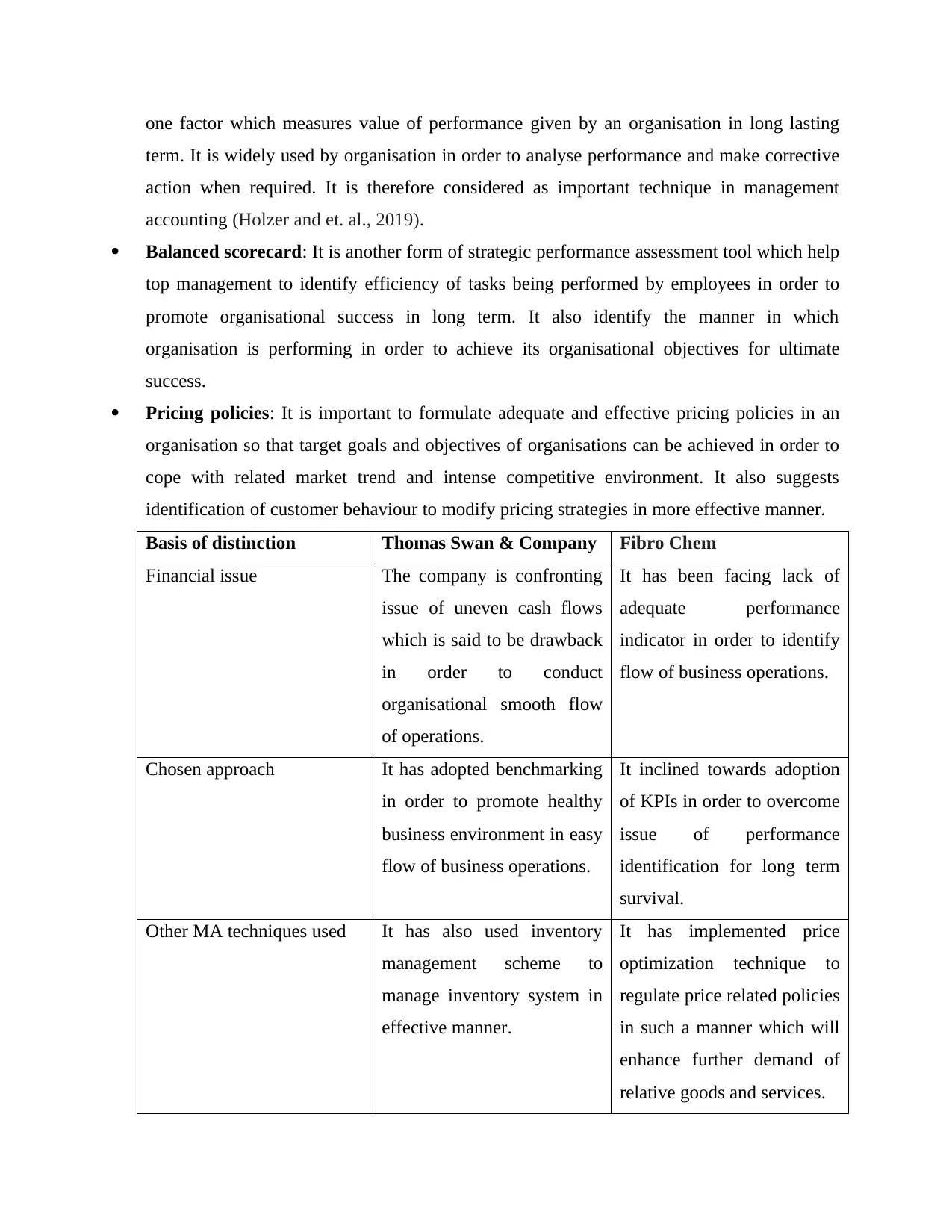
one factor which measures value of performance given by an organisation in long lasting
term. It is widely used by organisation in order to analyse performance and make corrective
action when required. It is therefore considered as important technique in management
accounting (Holzer and et. al., 2019).
Balanced scorecard: It is another form of strategic performance assessment tool which help
top management to identify efficiency of tasks being performed by employees in order to
promote organisational success in long term. It also identify the manner in which
organisation is performing in order to achieve its organisational objectives for ultimate
success.
Pricing policies: It is important to formulate adequate and effective pricing policies in an
organisation so that target goals and objectives of organisations can be achieved in order to
cope with related market trend and intense competitive environment. It also suggests
identification of customer behaviour to modify pricing strategies in more effective manner.
Basis of distinction Thomas Swan & Company Fibro Chem
Financial issue The company is confronting
issue of uneven cash flows
which is said to be drawback
in order to conduct
organisational smooth flow
of operations.
It has been facing lack of
adequate performance
indicator in order to identify
flow of business operations.
Chosen approach It has adopted benchmarking
in order to promote healthy
business environment in easy
flow of business operations.
It inclined towards adoption
of KPIs in order to overcome
issue of performance
identification for long term
survival.
Other MA techniques used It has also used inventory
management scheme to
manage inventory system in
effective manner.
It has implemented price
optimization technique to
regulate price related policies
in such a manner which will
enhance further demand of
relative goods and services.
term. It is widely used by organisation in order to analyse performance and make corrective
action when required. It is therefore considered as important technique in management
accounting (Holzer and et. al., 2019).
Balanced scorecard: It is another form of strategic performance assessment tool which help
top management to identify efficiency of tasks being performed by employees in order to
promote organisational success in long term. It also identify the manner in which
organisation is performing in order to achieve its organisational objectives for ultimate
success.
Pricing policies: It is important to formulate adequate and effective pricing policies in an
organisation so that target goals and objectives of organisations can be achieved in order to
cope with related market trend and intense competitive environment. It also suggests
identification of customer behaviour to modify pricing strategies in more effective manner.
Basis of distinction Thomas Swan & Company Fibro Chem
Financial issue The company is confronting
issue of uneven cash flows
which is said to be drawback
in order to conduct
organisational smooth flow
of operations.
It has been facing lack of
adequate performance
indicator in order to identify
flow of business operations.
Chosen approach It has adopted benchmarking
in order to promote healthy
business environment in easy
flow of business operations.
It inclined towards adoption
of KPIs in order to overcome
issue of performance
identification for long term
survival.
Other MA techniques used It has also used inventory
management scheme to
manage inventory system in
effective manner.
It has implemented price
optimization technique to
regulate price related policies
in such a manner which will
enhance further demand of
relative goods and services.
⊘ This is a preview!⊘
Do you want full access?
Subscribe today to unlock all pages.

Trusted by 1+ million students worldwide
1 out of 15
Related Documents
Your All-in-One AI-Powered Toolkit for Academic Success.
+13062052269
info@desklib.com
Available 24*7 on WhatsApp / Email
![[object Object]](/_next/static/media/star-bottom.7253800d.svg)
Unlock your academic potential
Copyright © 2020–2025 A2Z Services. All Rights Reserved. Developed and managed by ZUCOL.





